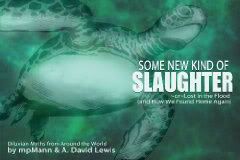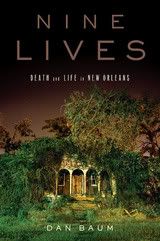Some New Kind of Slaughter: Lost in the Flood (and How We Found Home Again): Diluvian Myths from Around The World, from Archaia Studios Press, is now out. Given my connection to a certain diluvian story, creators A. David Lewis & mpMann asked me to write the foreword to the book, which I did. Here it is:
For me, it all began with the 2004 Asian tsunami. Horrified by the huge loss of life, I was also fascinated by the imagery, by the idea that life-giving water could bring such epic death and destruction. I remember trolling the Internet for video from the tsunami, watching YouTube clips over and over again. What was most mesmerizing about what I saw was not that the water came in crashing waves, but rather that it seemed to surge from below, to inexorably grow deeper and deeper, like some nightmare from which you couldn’t wake. And that was exactly it — the tsunami, the flooding, the very themes of water and drowning, were like dreams, a nightmare millions of helpless people shared that late-December night in 2004.
 Less than a year later, when Hurricane Katrina struck the U.S. Gulf Coast, I experienced the same morbid fascination with the storm surge and the flooding of New Orleans. This time, however, I was moved to action. For whatever reason, I woke from my waterlogged reverie and volunteered with the Red Cross. Almost before I knew it, I was in the Gulf Coast, providing emergency relief to those left behind. Walking through the rubble of Biloxi, Mississippi, and listening to the clients’ survival stories made the experience all too real, but the rising waters still haunted my dreams. Perhaps they always will.
Less than a year later, when Hurricane Katrina struck the U.S. Gulf Coast, I experienced the same morbid fascination with the storm surge and the flooding of New Orleans. This time, however, I was moved to action. For whatever reason, I woke from my waterlogged reverie and volunteered with the Red Cross. Almost before I knew it, I was in the Gulf Coast, providing emergency relief to those left behind. Walking through the rubble of Biloxi, Mississippi, and listening to the clients’ survival stories made the experience all too real, but the rising waters still haunted my dreams. Perhaps they always will.
So for me at least, mpMann and A. David Lewis’s Some New Kind of Slaughter is especially resonant. Mainly through the visions of the ancient Sumerian king Ziusudra, adrift on his great ark, Mann and Lewis take the reader on a dreamlike tour through the world’s great flood myths. From Babylonia to the Nile Delta, from the Chinese tales of Da Yu to the Native American Menomines, and from modern-day eco-warriors to the Old Testament, we see how these disparate creation and destruction myths share themes of divine punishment, visionary pariahs, and… turtles? Even the familiar story of Noah comes to life in unexpected ways.
Humor leavens the tales. The ancient stories, cultures, and names go down easy via Lewis’s characters’ naturalistic, witty dialogue. And Mann’s beautiful, painterly art completely meshes with the story. The expert weaving of word and image is augmented by the landscape-style alignment of the pages, a device that would seem gimmicky in other contexts, but here reinforces the hallucinatory narrative.
Reading this book reminded me of my youthful backpacking days. Traveling through Southeast Asia and Central Europe, I read author Gore Vidal’s series of historical novels tracing the exploits of one family through American history. Completely captivated by Vidal’s unique vision and his gleeful assault on our cultural myths, when I returned home I sought out the primary sources, reading up on events I hadn’t thought about since high school. I thoroughly enjoyed that journey, and will always be grateful to Vidal for his expert use of the art of fiction to teach fact. Some New Kind of Slaughter does the exact same thing.
The human instinct to tell stories — to make sense of the senseless, to impose order on what seems like the capricious whims of nature — is timeless. What began with poems around a fire, or ancient symbols on cracked parchment, comes to us now in the form of viral video and the pages of the graphic novel. Like a dream shared across cultures and history, Some New Kind of Slaughter ties our modern present to the ancient and/or biblical past. It is a triumphant demonstration that the graphic novel may be the future’s best teaching tool.

 Less than a year later, when Hurricane Katrina struck the U.S. Gulf Coast, I experienced the same morbid fascination with the storm surge and the flooding of New Orleans. This time, however, I was moved to action. For whatever reason, I woke from my waterlogged reverie and volunteered with the Red Cross. Almost before I knew it, I was in the Gulf Coast, providing emergency relief to those left behind. Walking through the rubble of Biloxi, Mississippi, and listening to the clients’ survival stories made the experience all too real, but the rising waters still haunted my dreams. Perhaps they always will.
Less than a year later, when Hurricane Katrina struck the U.S. Gulf Coast, I experienced the same morbid fascination with the storm surge and the flooding of New Orleans. This time, however, I was moved to action. For whatever reason, I woke from my waterlogged reverie and volunteered with the Red Cross. Almost before I knew it, I was in the Gulf Coast, providing emergency relief to those left behind. Walking through the rubble of Biloxi, Mississippi, and listening to the clients’ survival stories made the experience all too real, but the rising waters still haunted my dreams. Perhaps they always will. I recently finished reading
I recently finished reading  Done! On Thursday I uploaded A.D. to the Random House/Pantheon FTP. Finally, after two solid years on the project, I completed the book.
Done! On Thursday I uploaded A.D. to the Random House/Pantheon FTP. Finally, after two solid years on the project, I completed the book. 
